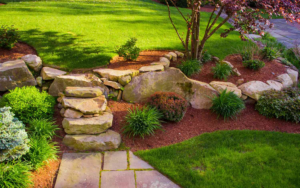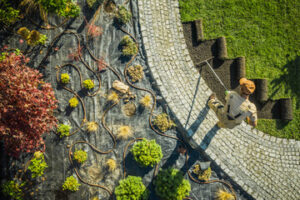Landscaping increases property value, reduces energy costs, and provides a healthy outdoor environment. It also enhances biodiversity and improves local air quality.
Creating variety in the landscape through diversity of form, color, texture and repetition adds depth and intrigue to the design (Figure 19-25). Lines are also important in directing the eye throughout the landscape. Visit our Website to learn more.

Form is the three-dimensional qualities of a landscape — the shapes of flowerbeds, ponds and facets of architecture are important in creating interesting lines. Landscape designers also consider the lines that carry the eye through a landscape, affecting how people respond emotionally and physically to a space. For example, straight lines have a formal character and direct the eye toward a focal point. Conversely, curved lines create a more natural and relaxed character.
In landscaping, shape is often used interchangeably with form, although there is a distinction between the two. While shape describes the flat silhouette of a plant, its form is its enduring characteristics. For example, a shrub may grow in a round or vase shape but its form is the way the plant grows over time. Grouping plants or structures together can impact their appearance as well, turning them into larger forms that draw the eye. For example, a circular driveway can be visually expanded by surrounding the driveway with low plants or structures, such as flowerbeds and boulders.
Color is another design element that can change how people respond to a space, especially when it’s combined with other elements of composition like line and texture. For instance, the bright sunlight of summer makes colors seem more saturated and intense while filtered light in winter can make them appear less vibrant. In landscape design, colors can also be manipulated by varying lighting or adding textures.
Functionality is a key factor when designing landscapes, as it ensures that the landscape meets a practical purpose. For example, a public park might have shaded seating areas to reduce sun exposure or drought-tolerant plantings to reduce water consumption. Alternatively, a rain garden can be incorporated to manage stormwater and reduce stress on local wastewater systems.
While function is essential, form is what gives a landscape its emotional resonance. Landscapes that prioritize form are more appealing because they evoke feelings and emotions when people interact with them. In a residential landscape, for example, rounded and natural forms can soften the edges of hardscaped surfaces or outdoor structures, while angular forms add order to the space and introduce visual mass.
Color
Color is one of the strongest design elements, grabbing attention and guiding the eye. It can help to evoke specific emotions, make smaller spaces appear larger or unify different areas of the landscape. When designing a landscape, it’s important to consider which colors go well together, how to repeat them to balance and look harmonious and what the best way is to introduce seasonal variations into your palette.
It’s also essential to understand how light affects the color of your landscape. Shades and tints of the same color can have a dramatically different effect depending on how much light they receive. In general, things that receive a lot of direct sunlight will be brighter and more saturated while those in the shadows will be darker and less saturated.
When choosing a color scheme, it’s a good idea to begin with a base palette that contains the basic colors you’ll need for your landscape. These include titanium white, ultramarine blue, cadmium yellow and burnt sienna. Once you’ve established your base, you can start to introduce custom colors that resonate with your style.
Some of the most popular landscape colors are warm reds and oranges that evoke excitement and warmth, while cool greens and blues offer tranquility. Another option is a monochromatic color scheme, which uses shades and tints of the same color for a cohesive look that still allows room for creativity. For example, a shady woodland garden could include varying shades of green and accent the plants with purple flowers such as hydrangeas and black eyed susans.
Lastly, a riotous color scheme is bold and dramatic and can be used to create focal points in the landscape. It’s a great idea to use this type of scheme sparingly because too many colors can quickly overwhelm and create a chaotic feel.
It’s also important to remember that it takes time to master the skill of choosing the right color for a particular landscape. To do so, it’s a good idea to spend some time observing natural landscapes and how the light effects them, how colors change with the seasons and how different textures are combined.
Texture
Landscape designers use texture to add depth, interest and a tactile dimension to a garden. It is one of the ten key principles and can be created using plants, rocks, mulch, grasses, shrubs and even hardscape elements like fencing or flagstone. It is important to balance the use of textures throughout a landscape because too much of any one will overwhelm the visual impact.
Texture encompasses the roughness or fineness of a plant’s leaves, the thickness of its stems and branches and its overall density. It is also determined by color and the overall appearance of a plant, with bold colors creating contrast and finer hues blending into their surroundings. The shape of a plant’s leaves or twigs can also create its texture, with broad leaves adding a coarse feeling and narrow ones creating a more refined look. Texture can also be determined by the size of a plant, with larger plants appearing coarser and smaller ones having a finer appearance.
The perception of a landscape’s texture can also change depending on the viewer’s distance from it. Close-up, coarse textured plants may appear to be fine if the surrounding landscape is composed of rough rock and bold timbers, while coarse foliage can blend in with a medium textured garden when planted among shrubs that have large leaved flowers and rounded forms.
In addition, a landscape’s texture changes with the season. Rough bark on a tree or shrub creates a different visual texture in winter than the lush green of a summer garden. In addition, the rough texture of a rock or retaining wall can be appealing in the winter when it is covered with frost and snow, while soft mulches and frosted berries provide a subtle contrast.
Ultimately, the textures of your landscape should match the aesthetic of your home and fit with your maintenance capabilities. A predominantly coarse-textured garden can become overbearing in a small space, while a finely textured landscape may not stand out against the backdrop of a large stone or wood home. By incorporating the right textures into your landscape, you can ensure that it is visually stimulating and enjoyable throughout the year.
Lighting
A well-lit landscape adds safety, extends outdoor living spaces and provides a beautiful focal point. Whether you’re designing a new space or renovating an old one, think about the addition of landscaping lighting early in the planning stages. It will help keep costs down in the long run and prevent costly changes later on.
The right landscape lighting can highlight a garden trellis, water feature or a statue, drawing the eye where you want it to go and adding drama at night. You can use various techniques to achieve this, such as uplighting, which shines light upward on an object to create dramatic visuals, or silhouetting, which uses low lighting angled down to wash the subject in soft light.
Lines are another important consideration in a landscape design, establishing a sense of direction and creating focal points with landscape objects like garden beds and water features. Using lines to guide the eye through your space can also draw attention to key features, and make way for seating areas where guests can relax.
As you plan your landscape, choose a style theme to guide the selection of plants and other elements. Themes can be as simple as a color palette or as complex as a specific architectural style, such as French, Italian or English gardens. You can also choose a planting style such as meadow, woodland or seaside to create a natural feel to your space.
The type of landscape lighting you choose will depend on the areas you wish to illuminate, and the types of fixtures that best suit your design scheme. Lighting fixtures are available in a range of styles, from classic to modern, and can be integrated with smart home systems for added convenience. Energy efficiency, sustainability and integration with your landscape and home are other factors that influence your choice.
While it’s possible to DIY the installation of some types of landscape lighting, most projects require a professional. Wired lighting needs to be connected to your electrical system and will likely require cutting into soffits, which is better left to a pro. And any landscaping lighting near or around water features will need to be installed by a pro, as electricity and water don’t mix well.
